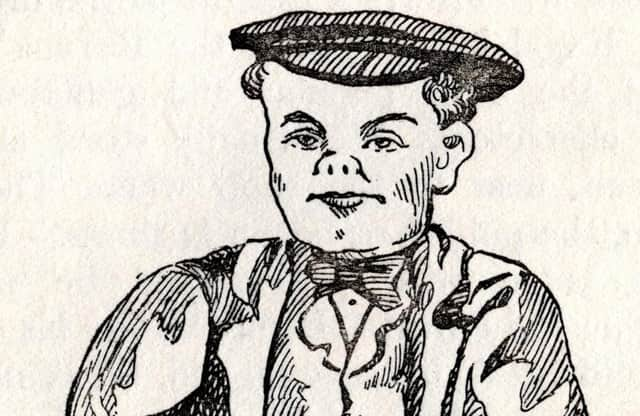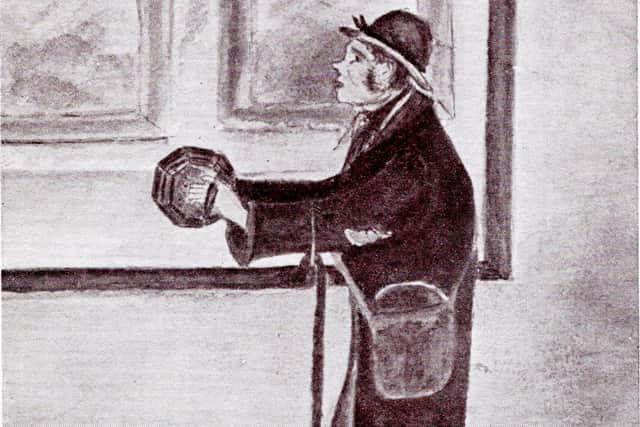Old Edinburgh Worthies 6: Swing Charlie, Cramond Willie, Caunle Doup and Burn the Bible


SWING CHARLIE
Swing Charlie, called by some Charlie Napier, was a blind street musician active in Victorian times. He sang and played an English concertina, performing quite creditably and remaining one of the best known Edinburgh street characters for many years.
A short, spare man, he was often harassed by the mischievous street boys, who sneaked up behind him and shouted "Boo!" during his performances.Charlie had a thick, heavy stick hanging from his coat button, and when he could stand the molestation no longer, he made this weapon ready for use. "Swing, Charlie! Swing!", shouted the delighted street urchins as the exasperated Charlie swung his stick hard at them.


Advertisement
Hide AdAdvertisement
Hide Ad‘We boys respected that stick when we made him angry,’ wrote the chronicler AJ Baillie many years later.
CRAMOND WILLIE
Cramond Willie as his nickname suggests, was a native of Cramond. His real name was William Henderson. The 1851 Census tells us that Willie was 30 years old at the time, living at One House Buildings in Cramond Village with his father John and his mother Alison, who were both in their fifties. He also had three younger sisters named Margaret, Eliza and Sarah.
Able-bodied but "of weak intellect", Willie found paid employment carrying letters and messages between Cramond and Edinburgh, in a large arm-basket. He was described as a tall man, always well dressed and respectable, and quiet and courteous in manner, but not "all there" with regard to his mental acuity.
When the street boys asked him, "What’s the time, Willie?", he gazed up in the sky, lacking a proper watch, and estimated the hour fairly correctly.
Advertisement
Hide AdAdvertisement
Hide AdUnlike Swing Charlie and Walking Dick, who were constantly at loggerheads with the mischievous street urchins of Edinburgh, Willie was quite popular and seldom molested.
The 1861 Census finds Willie at 1 Shore Street, Cramond Village, described as a parcel carrier and messenger and living with his father John and sister Margaret. In 1871, the Hendersons were at 6 Shore Street, with the 79-year-old John, described as a former general labourer and a pauper, still hale and hearty.
In November 1878, The Scotsman could announce the death of Cramond Willie. The cause of death was a stroke of paralysis at the age of just 57, leading to hemiplegia from which Willie had expired on November 24 1878.
His headstone still stands, with the inscription, 'Erected by the Parishioners of Cramond and other friends in memory of Cramond Willie (William Henderson) who was for many years a faithful messenger between Cramond and Edinburgh. In character and conduct he was an honest and upright man.”
CANULE DOUP
Advertisement
Hide AdAdvertisement
Hide AdThe real name of Caunle Doup cannot be discerned, but he was an Edinburgh worthy in his time, active in the candle trade and often carrying a large basket of candles.
He was almost as broad as he was tall, with an abnormally large head, and short arms and legs. This figure was much teased by the street boys.
WILLIE O’ THE MOUND
Willie o’ the Mound, whose effigy was immortalised in WJ Hay’s Knox Series of postcards, appears to have been a street beggar of some description.
BURN THE BIBLEBurn the Bible was also known as Cripple Kirsty or Kirsty Veitch; the latter may well have been her true name, although this cannot be verified.
Advertisement
Hide AdAdvertisement
Hide AdDescribed as a short, toothless crone of sinister aspect, she was constantly at loggerheads with the street boys, who shouted, "Burn the Bible!" to make her furious. It was well known among the street urchins of Edinburgh that Kirsty had once burnt the Bible, for whatever reason, and that this act of sacrilege had made her ‘go daft in the heid’.
Poet Donald Campbell was inspired by her sinister reputation:When the gloaming light is spentYe’ll maybe see auld Kirsty rideAbove the towering tenementWhere all the ghosts and gremlins bide …Other female Edinburgh worthies of the time were the Newhaven fishwives Maggie Flucker and Oyster Nell, and the Bible Land lodging-house keeper Black Mary, who was known for her short temper and great bodily strength.
Jan Bondeson is author of Phillimore's Edinburgh, published by Amberley Books and Murder Houses of Edinburgh
A message from the Editor:
Thank you for reading this article. We're more reliant on your support than ever as the shift in consumer habits brought about by coronavirus impacts our advertisers.
If you haven't already, please consider supporting our trusted, fact-checked journalism by taking out a digital subscription
Comment Guidelines
National World encourages reader discussion on our stories. User feedback, insights and back-and-forth exchanges add a rich layer of context to reporting. Please review our Community Guidelines before commenting.